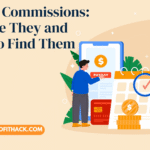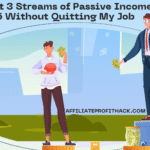Welcome to my article “How to Choose a Profitable Niche for Your Dropshipping Business”.
You have decided to dive into the world of dropshipping—congratulations! You’re now about to embark on an exciting (and sometimes frustrating) journey of selling products without ever touching them. But before you start dreaming about passive income and sipping cocktails on the beach, there’s one crucial decision that can make or break your success: choosing the right niche.
Think of your dropshipping niche like picking a dating app—it’s all about finding the right match. Choose too broad of a niche, and you’ll be lost in a sea of competition. Go too niche, and you might end up selling cat hammocks to an audience of three. The key is to find a profitable, in-demand niche with enough buyers but not too much competition. Sounds tricky? Don’t worry, I’ve got you covered. In this guide, we’ll break down exactly how to spot winning niches, analyze demand, evaluate competition, and ensure profitability—without relying on pure guesswork. By the end, you’ll have a clear strategy to pick a dropshipping niche that actually makes money (instead of just making you question your life choices). Ready to find your perfect dropshipping niche? Let’s get started!
My Best Recommended & Proven Way to Make $100-$300 Daily – Watch This FREE Video to START >>>

Understanding Market Demand: Finding What Sells
Imagine opening a dropshipping store and realizing no one actually wants what you’re selling. Ouch. That’s like throwing a party and forgetting to send out invites. Before you invest time and money into a niche, you need to make sure people actually want what you’re selling—and preferably, they want it badly enough to pull out their wallets.
So, how do you figure out what’s hot and what’s not? Start with Google Trends. This free tool shows you whether a product’s interest is rising or falling. If you see a steady climb or consistent search volume, you might be onto something. On the other hand, if the interest graph looks like a roller coaster at an abandoned theme park, you may want to reconsider. Another goldmine? Amazon Best Sellers and TikTok trends. If a product is consistently ranking high on Amazon or going viral on TikTok, that’s a sign there’s strong demand. But don’t just follow the hype—trending products are great, but you also want a niche with long-term demand, not just a passing fad (RIP fidget spinners).
Finally, spy on your competition. A quick search on Facebook Ads, Shopify stores, or even AliExpress can tell you which products are already selling well. If you see multiple dropshippers running ads for a product, chances are, it’s making money. The trick is finding a balance: you want something that has proven demand but isn’t oversaturated with competition. If everyone and their grandmother is selling it, you might have a hard time standing out.
In short, market demand is everything. Get this step right, and you’re setting yourself up for success. Skip it, and you might end up dropshipping products no one asked for—like glow-in-the-dark shoelaces (unless that’s secretly a billion-dollar niche, in which case, ignore everything I just said).
Evaluating Competition: Finding the Right Balance
Picking a dropshipping niche without checking the competition is like walking into a boxing ring blindfolded. You might land a lucky punch, but chances are, you’re going to get knocked out fast. The goal isn’t to avoid competition entirely (because that usually means there’s no demand), but you also don’t want to enter a battlefield where massive brands with deep pockets are already dominating. The trick is finding that sweet spot—a niche that has buyers but isn’t completely saturated.
So, how do you check the competition? First, do a quick Google search for your potential niche. If the entire first page is filled with big brands like Amazon, Walmart, and well-established e-commerce stores, you’re going to have a tough time ranking organically. On the flip side, if you find smaller Shopify stores selling products in the niche, that’s a good sign—it means independent sellers are making money. Another quick check? Facebook and TikTok Ads. If you see multiple dropshipping ads for a product, that means it’s selling, but if you see too many identical ads, the market might be oversaturated.
My Best Recommended & Proven Way to Make $100-$300 Daily – Watch This FREE Video to START >>>
Now, let’s talk tools. Platforms like SEMrush, Ahrefs, and SimilarWeb can help you analyze competitor websites, check their traffic sources, and see how difficult it would be to compete. If a niche has strong demand but only a handful of small-to-medium competitors, you might have found your golden opportunity. On the other hand, if every competitor is spending thousands on ads and ranking at the top of Google, you might need a different angle—like niching down further or offering a unique selling point.
In short, competition is healthy, but too much of it can crush your chances before you even start. Do your research, assess your odds, and make sure you’re stepping into a niche where you can actually compete—not one where you’re instantly outmatched.
Profitability Factors: High Margins and Low Costs
If you are in dropshipping just for fun, you might as well be donating your time to charity. But if you actually want to make money, you need to focus on one thing: profit margins. Because let’s be real—selling 1,000 products at a $1 profit per sale is a lot more painful than selling 100 products at a $10 profit.
The math is simple: Revenue – Cost = Profit. But here’s where most beginners go wrong—they pick products with razor-thin margins, thinking they can make up for it with volume. Spoiler alert: That rarely works. Between ad costs, transaction fees, and supplier charges, a $5 profit per sale can quickly turn into cents. That’s why you want products that allow for at least a 3X markup—if it costs you $10, you should be able to sell it for $30 or more.
So, how do you find high-margin products? Look for items that have a perceived value—things that people are willing to pay extra for. Jewelry, home decor, and fitness accessories, for example, can sell for much more than their actual production cost. On the other hand, common everyday items (like USB cables or generic phone cases) are harder to mark up because people know they’re cheap. Another trick? Avoid products with high return rates. If you’re selling something fragile, complicated, or prone to customer complaints, you’ll spend more time processing refunds than making profits.
And then there’s the cost side. Shipping fees, supplier pricing, and ad spend all eat into your margins. The goal is to keep costs as low as possible without sacrificing quality—because no one wants to deal with angry customers who waited a month for a product that fell apart in two days. The best approach? Work with reliable suppliers on platforms like AliExpress, Spocket, or CJ Dropshipping, and negotiate bulk discounts once you start scaling.
At the end of the day, dropshipping isn’t just about selling things online—it’s about selling the right things at the right price. Choose wisely, and you’ll be banking profits. Choose poorly, and you’ll be left wondering why your store is working harder than you are.
Target Audience Research: Who Are Your Buyers?
Selling a product without knowing your audience is like throwing darts in the dark—you might hit something, but chances are, you’re just wasting time (and money). The truth is, understanding your buyers is just as important as choosing the right niche. You’re not just selling a product—you’re solving a problem, fulfilling a desire, or feeding an obsession. And to do that effectively, you need to know exactly who you’re talking to.
Start with the basics: Who needs this product? Are they young professionals, busy parents, fitness enthusiasts, pet lovers, or die-hard gadget nerds? More importantly, why would they buy it? Are they looking to save time, improve their health, follow a trend, or just show off on Instagram? People don’t just buy things—they buy solutions, emotions, and experiences. The better you understand that, the easier it is to market your product.
My Best Recommended & Proven Way to Make $100-$300 Daily – Watch This FREE Video to START >>>
Now, let’s do some digging. Facebook Groups, Reddit, and Quora are goldmines for audience insights. If you’re thinking about selling pet accessories, check out Facebook Groups full of passionate dog owners—they’ll practically tell you what they wish existed. If your niche is fitness, scroll through Reddit threads where people discuss gym struggles. These places are filled with real people sharing real problems—aka, business opportunities waiting to happen.
And then there’s the buying behavior side of things. Where does your audience hang out online? Do they shop on Instagram? Are they more likely to buy through TikTok? Do they trust influencer recommendations or prefer reading in-depth reviews? Knowing this helps you choose the right marketing strategy. Selling trendy fashion items? TikTok and Instagram are your playground. Selling high-ticket home gadgets? You might have better luck with YouTube reviews and Google Ads.
Bottom line: Your product isn’t for everyone—and that’s a good thing. The clearer you are on who your buyers are, what they want, and where they spend their time, the easier it is to sell to them. Otherwise, you’re just hoping for sales instead of creating them.
Testing and Validating Your Niche Before Committing
Imagine spending weeks setting up a dropshipping store, only to hear crickets when you launch. No sales, no traffic, just the sound of your credit card bill reminding you of all the money you spent on ads. Painful, right? That’s why testing your niche before going all in is non-negotiable. The goal isn’t just to think a niche will work—it’s to prove it before you waste time and money.
Step one: Run a quick validation test with social media ads. Set up a simple Facebook or TikTok ad campaign targeting your potential audience. No need to spend hundreds—$20-$50 is enough to see if people are even clicking. If no one cares about your product, that’s your first red flag. But if people are engaging, clicking, or even adding to cart, you might be onto something.
Step two: Check supplier availability and pricing. Just because you found a cool product on AliExpress doesn’t mean it’s actually a good business idea. Make sure suppliers have stable inventory, reasonable shipping times, and bulk pricing options for when you scale. If a product is constantly out of stock or takes 45 days to arrive, your customers will lose patience before you make a dime.
Step three: Test with a minimum viable store. You don’t need a full-blown Shopify masterpiece to see if a niche works. A simple one-product landing page or even an Etsy/Amazon listing can tell you a lot. The goal is to get real buyers, not just hypothetical ones. If you can get even a handful of sales with minimal effort, that’s your green light to go all in.
At the end of the day, dropshipping success isn’t about guessing—it’s about testing. If your niche passes the test, you’re setting yourself up for a profitable store. If it fails? Better to find out early than after you’ve sunk hours (and dollars) into something no one wants.
Conclusion
Picking the right dropshipping niche isn’t about chasing the latest trend or picking something just because it sounds cool. It’s about finding a balance between demand, competition, profitability, and the right audience—all backed by actual research, not just gut instinct. The last thing you want is to spend months building a store only to realize you’re selling something no one wants, or worse, something everyone is already selling at razor-thin margins.
The good news? You don’t need to reinvent the wheel—you just need to validate your niche before committing. Use Google Trends, spy on competitors, test with small ad campaigns, and make sure your margins actually make sense. The best dropshipping stores aren’t built on guesswork—they’re built on data-driven decisions. If you do your research, test wisely, and choose a niche that people want to buy from, you’re already ahead of most beginners who dive in blind.
My Best Recommended & Proven Way to Make $100-$300 Daily – Watch This FREE Video to START >>>
So, before you go all in, ask yourself: Is there demand? Can I compete? Are the margins worth it? Do I actually know who my buyers are? If the answer is yes, you’re on the right track. If not, tweak your approach and test again. Success in dropshipping isn’t about luck—it’s about choosing the right niche and executing smartly. Now, go find your winning niche and start building that business.
Thank you for reading my article “How to Choose a Profitable Niche for Your Dropshipping Business” till the end. Hope it helped you. See you with another article.










